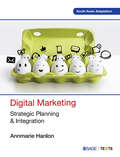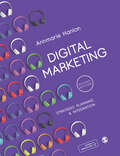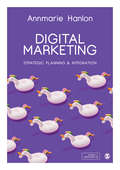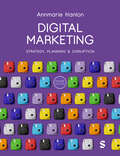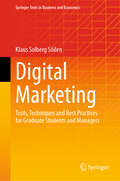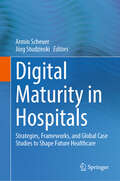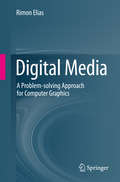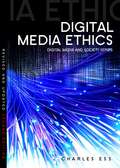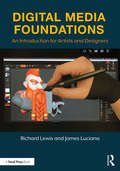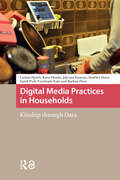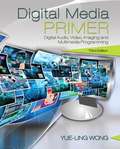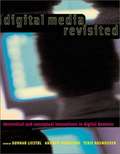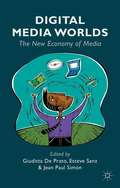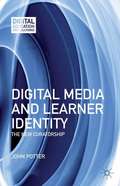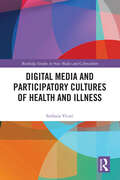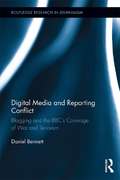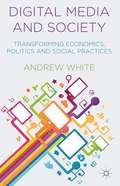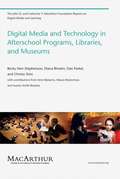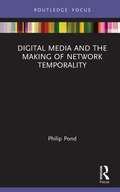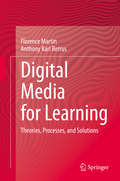- Table View
- List View
Digital Marketing: Strategic Planning & Integration
by Annmarie HanlonCovering all aspects of digital marketing planning, the book aims to provide a roadmap for a digital marketing journey. An unbiased approach to the latest digital marketing models, offering students and practitioners a range of tools to implement in their digital marketing planning and strategy. Covering all aspects of digital marketing planning, the book aims to provide a roadmap for a digital marketing journey. This book has been structured to map the development of a digital marketing plan and concludes with a ready-made plan template to download and adapt. In addition, the content is supported by case examples from real-world organizations, and a number of pedagogical features throughout the chapters. The book is suitable for digital and e-marketing courses as well as professional courses for anyone interested in gaining a holistic understanding of digital marketing. Key Features: • Smartphone sixty seconds features in every chapter to evaluate influencers in relation to the topic covered • Digital tool boxes introduce professional tools • Ethical insights provide a reflective and challenging look at social issues and the negative sides of marketing.
Digital Marketing: Strategic Planning & Integration
by Annmarie HanlonAn unbiased, balanced guide to all aspects of digital marketing, from social media, mobile and VR marketing to objectives, metrics and analytics. Covering all aspects of digital marketing planning and the latest models, the book also offers a range of tools to help implement your own digital marketing plans and strategies. The second edition has been expanded to include new discussions and research on areas including digital privacy, types of influencers, social listening and the gig economy. Key features: Supported by case examples from 28 global companies and brands including IKEA, Uber, Klarna and TikTok. A brand-new case study on Strava runs throughout the book to help you apply what you’ve learnt to real-world scenarios. ‘Ethical Insight’ boxes provide a reflective and challenging look at social issues and the negative side of marketing. ‘Digital Tool’ boxes introduce professional tools, such as ‘Spot the Troll’, Hootsuite and Padlet. The ‘Smartphone Sixty Seconds’ feature provides super-quick online activities using needing only your phone. Includes a new ‘Journal of Note’ feature in each chapter, to direct you to a key source of further reading. Worked digital marketing plan. Complimented by online resources, including PowerPoint slides, and Instructor’s Manual, quizzes, recommended video links and free SAGE Journal articles. Suitable for digital and e-marketing courses at all levels, as well as professional courses for anyone interested in gaining a holistic understanding of digital marketing.
Digital Marketing: Strategic Planning & Integration
by Annmarie HanlonAn unbiased, balanced guide to all aspects of digital marketing, from social media, mobile and VR marketing to objectives, metrics and analytics. Covering all aspects of digital marketing planning and the latest models, the book also offers a range of tools to help implement your own digital marketing plans and strategies. The second edition has been expanded to include new discussions and research on areas including digital privacy, types of influencers, social listening and the gig economy. Key features: Supported by case examples from 28 global companies and brands including IKEA, Uber, Klarna and TikTok. A brand-new case study on Strava runs throughout the book to help you apply what you’ve learnt to real-world scenarios. ‘Ethical Insight’ boxes provide a reflective and challenging look at social issues and the negative side of marketing. ‘Digital Tool’ boxes introduce professional tools, such as ‘Spot the Troll’, Hootsuite and Padlet. The ‘Smartphone Sixty Seconds’ feature provides super-quick online activities using needing only your phone. Includes a new ‘Journal of Note’ feature in each chapter, to direct you to a key source of further reading. Worked digital marketing plan. Complimented by online resources, including PowerPoint slides, and Instructor’s Manual, quizzes, recommended video links and free SAGE Journal articles. Suitable for digital and e-marketing courses at all levels, as well as professional courses for anyone interested in gaining a holistic understanding of digital marketing.
Digital Marketing: Strategic Planning & Integration (Quick Win Ser.)
by Annmarie HanlonAn unbiased approach to the latest digital marketing models, offering students and practitioners a range of tools to implement in their digital marketing planning and strategy. Covering all aspects of digital marketing planning, and the latest digital marketing models, the book aims to provide a roadmap for a digital marketing journey. As such, its structure maps against the development of a digital marketing plan and concludes with a ready-made digital marketing plan template to download and adapt. In addition to this, the content is supported by case examples from real-world organizations, and a number of features throughout the chapters: Smartphone sixty seconds features in every chapter, to evaluate influencers in relation to the topic covered. Digital tool boxes introduce professional tools (for example how Google shares its aggregate data to inform marketers about shopping insights, trends and benchmarks Ethical insights provide a reflective and challenging look at social issues and the negative sides to marketing. The book is complemented by online resources for both instructors and students, these include PowerPoint slides, an instructor’s guide, exercises and activities relating to each chapter, digital marketing planning documents, digital marketing model templates, quizzes, annotated recommended video links, links to free online tools and SAGE journal article recommendations. Suitable for digital and e-marketing courses on marketing and advertising degrees as well as professional courses for anyone interested in gaining a holistic understanding of digital marketing.
Digital Marketing: Strategic Planning & Integration (Quick Win Ser.)
by Annmarie HanlonAn unbiased approach to the latest digital marketing models, offering students and practitioners a range of tools to implement in their digital marketing planning and strategy. Covering all aspects of digital marketing planning, and the latest digital marketing models, the book aims to provide a roadmap for a digital marketing journey. As such, its structure maps against the development of a digital marketing plan and concludes with a ready-made digital marketing plan template to download and adapt. In addition to this, the content is supported by case examples from real-world organizations, and a number of features throughout the chapters: Smartphone sixty seconds features in every chapter, to evaluate influencers in relation to the topic covered. Digital tool boxes introduce professional tools (for example how Google shares its aggregate data to inform marketers about shopping insights, trends and benchmarks Ethical insights provide a reflective and challenging look at social issues and the negative sides to marketing. The book is complemented by online resources for both instructors and students, these include PowerPoint slides, an instructor’s guide, exercises and activities relating to each chapter, digital marketing planning documents, digital marketing model templates, quizzes, annotated recommended video links, links to free online tools and SAGE journal article recommendations. Suitable for digital and e-marketing courses on marketing and advertising degrees as well as professional courses for anyone interested in gaining a holistic understanding of digital marketing.
Digital Marketing: Strategy, Planning & Disruption
by Annmarie HanlonYour complete and accessible guide to all aspects of digital marketing, from tools and channels to strategy, planning and marketing management. This fully updated third edition explores the application of AI in marketing, how digital disruption leads to transformation, and the Metaverse and its different realities. It also highlights the UN Sustainable Development Goals in each chapter and how these apply to marketing. With an excellent blend of theory, research, practice and application, key features include: • New case studies from a range of global organizations from 20 countries, including Back Market, Spotify and Nykaa. • A new running case study throughout the book which looks at Uber. • Ethical Insights which highlight responsible marketing and support PRME. • Professional Skills which address employability. • Discover More and Digital Tools text boxes. • Activities, exercises and Smartphone Sixty Seconds® icebreakers which help students apply their understanding of each chapter. Essential reading for all students and practitioners of digital marketing. Looking for a step-by-step guide to creating a digital marketing plan? Save by buying Digital Marketing with Annmarie Hanlon′s Digital Marketing Planner.
Digital Marketing: Strategy, Planning & Disruption
by Annmarie HanlonYour complete and accessible guide to all aspects of digital marketing, from tools and channels to strategy, planning and marketing management. This fully updated third edition explores the application of AI in marketing, how digital disruption leads to transformation, and the Metaverse and its different realities. It also highlights the UN Sustainable Development Goals in each chapter and how these apply to marketing. With an excellent blend of theory, research, practice and application, key features include: • New case studies from a range of global organizations from 20 countries, including Back Market, Spotify and Nykaa. • A new running case study throughout the book which looks at Uber. • Ethical Insights which highlight responsible marketing and support PRME. • Professional Skills which address employability. • Discover More and Digital Tools text boxes. • Activities, exercises and Smartphone Sixty Seconds® icebreakers which help students apply their understanding of each chapter. Essential reading for all students and practitioners of digital marketing. Looking for a step-by-step guide to creating a digital marketing plan? Save by buying Digital Marketing with Annmarie Hanlon′s Digital Marketing Planner.
Digital Marketing: Tools, Techniques and Best Practices for Graduate Students and Managers (Springer Texts in Business and Economics)
by Klaus Solberg SöilenThis textbook balances the theory of digital marketing with the practical skills for prospective marketers in professional organizations, both public and private. It begins with an introduction to the digital landscape following the structure of market segmentation, B2C, B2B applications, as a starting point, of digital marketing. It then takes the readers through the customer journey, use of social media, and the rising importance of video-based communication. Given this background, students will learn the organization, technical skills and project management needed for digital marketing, including online public relations, communications, and internet branding. An extensive summary of strategies necessary to work with digital marketing in a longer perspective is also provided.
Digital Maturity in Hospitals: Strategies, Frameworks, and Global Case Studies to Shape Future Healthcare
by Armin Scheuer Jörg StudzinskiThis book serves as a comprehensive guide for hospitals embarking on a digital maturity journey, offering actionable insights, best practices, and lessons learned from healthcare leaders worldwide. It brings together contributions from over 50 world-renowned digital health experts, providing hospitals with the tools and strategies needed to successfully drive digital transformation to benefit both healthcare workers and patients. Covering a broad range of topics, the chapters delve into critical dimensions of hospital digitalization, including digital maturity models, IT capability, interoperability, governance, patient-centered care, and advanced data analytics. Readers will find real-world case studies showcasing hospitals and governmental initiatives that have achieved externally validated success in their digital transformation efforts. As emphasized in the Foreword written by the President of the International Diabetes Federation, the book highlights the impact of digital maturity on patient care and explores forward-looking trends that will shape the future of healthcare digitalization, such as green IT, ethical considerations, social determinants of health, and workforce development. Whether you are a healthcare leader, policy maker, or practitioner, this book offers valuable guidance and strategic insights to help you navigate your organization’s digital maturity journey and drive excellence in healthcare delivery.
Digital Mayhem 3D Landscape Techniques: Where Inspiration, Techniques and Digital Art meet
by Duncan EvansCompiled by Duncan Evans, founder and inspiration behind 3DArtist Magazine. The Masters at Work titles will offer digital inspiration with hands-on insight and techniques from professional digital artists. More than just a gallery book - each artist has written a breakdown overview, with supporting imagery of how they made their piece of work. Start your mentorship into the world of digital art today with some of the greatest digital artists in the world and delve into professional techiques. We are asking you to comment on the series itself and then the first title in the series. The first title in the series will focus on 3D Landscapes. You will be able to develop your landscape and background skills beyond the variety of free online tutorials and apply the most up to date techniques, like colour and contrast enhancements, sharpening, composition, lighting and more! Expand your digital canvas to include a variety of new software tools with Masters at Work: 3D Landscapes. There will be a supporting website with source files, downloadable content and artist tutorials, demonstrating key techniques of some of the greatest digital artists.
Digital Mayhem 3D Machine Techniques: Where Inspiration, Techniques and Digital Art meet
by Duncan EvansFrom Icy Tundras to Desert savannahs, master the art of landscape and environment design for 2D and 3D digital content. Make it rain, shower your digital scene with a snow storm or develop a believable urban scene with a critical eye for modeling, lighting and composition. Move beyond the limitations of gallery style coffee table books with Digital Mayhem: 3D Landscapes-offering leading professional techniques, groundbreaking inspiration, and artistic mastery from some of the greatest digital artists. More than just a gallery book - each artist has written a breakdown overview, with supporting imagery of how they made their piece of work. Compiled by Duncan Evans, founder and inspiration behind 3DArtist Magazine, start your mentorship into the world of digital art today with some of the greatest digital artists in the world! Develop your landscape and background skills beyond the variety of free online tutorials and apply the most up to date techniques, like colour and contrast enhancements, sharpening, composition, lighting and more! Expand your digital canvas to include a variety of software techniques, tools and workflows featuring Photoshop, Painter, Maya and 3ds Max examples. A source of inspiration for digital artists everywhere: more than 50 artists and 700 stunning color images are showcased with an in-depth companion website that includes professional source files and further technique based skills development.
Digital Media
by Rimon EliasFocusing on the computer graphics required to create digital media this book discusses the concepts and provides hundreds of solved examples and unsolved problems for practice. Pseudo codes are included where appropriate but these coding examples do not rely on specific languages. The aim is to get readers to understand the ideas and how concepts and algorithms work, through practicing numeric examples. Topics covered include: 2D Graphics 3D Solid Modelling Mapping Techniques Transformations in 2D and 3D Space Illuminations, Lighting and Shading Ideal as an upper level undergraduate text, Digital Media - A Problem-solving Approach for Computer Graphic, approaches the field at a conceptual level thus no programming experience is required, just a basic knowledge of mathematics and linear algebra.
Digital Media Ethics (Digital Media And Society Ser.)
by Charles EssThe original edition of this accessible and interdisciplinary textbook was the first to consider the ethical issues of digital media from a global perspective, introducing ethical theories from multiple cultures. <P><P>This second edition has been thoroughly updated to cover current research and scholarship, and recent developments and technological changes. It also benefits from extensively updated case-studies and pedagogical material, including examples of “watershed”events such as privacy policy developments on Facebook and Google+in relation to ongoing changes in privacy law in the US, the EU,and Asia. <P><P>New for the second edition is a section on “citizen journalism” and its implications for traditional journalistic ethics. With a significantly updated section on the “ethical toolkit,” this book also introduces students to prevailing ethical theories and illustrates how they are applied to central issues such as privacy, copyright, pornography and violence, and the ethics of cross-cultural communication online. <P><P>Digital Media Ethics is student- and classroom-friendly:each topic and theory is interwoven throughout the volume with detailed sets of questions, additional resources, and suggestions for further research and writing. Together, these enable readers to foster careful reflection upon, writing about, and discussion of these issues and their possible resolutions.
Digital Media Foundations: An Introduction for Artists and Designers
by Richard Lewis James LucianaThis book is a creative and practical introduction to the field of digital media for future designers, artists, and media professionals. It addresses the evolution of the field, its connections with traditional media, up-to-date developments, and possibilities for future directions. Logically organized and thoughtfully illustrated, it provides a welcoming guide to this emerging discipline. Describing each medium in detail, chapters trace their history, evolution, and potential applications. The book also explains important, relevant technologies—such as digitizing tablets, cloud storage, and 3-D printers—as well as new and emerging media like augmented and virtual reality. With a focus on concepts and creative possibilities, the text’s software-neutral exercises provide hands-on experiences with each of the media. The book also examines legal, ethical, and technical issues in digital media, explores career possibilities, and features profiles of pioneers and digital media professionals. Digital Media Foundations is an ideal resource for students, new professionals, and instructors involved in fields of graphic and visual arts, design, and the history of art and design.
Digital Media Practices in Households: Kinship through Data (MediaMatters)
by Sarah Pink Jolynna Sinanan Larissa Hjorth Heather Horst Kana OhashiHow are intergenerational relationships playing out in and through the digital rhythms of the household? Through extensive fieldwork in Tokyo, Shanghai and Melbourne, this book ethnographically explores how households are being understood, articulated and defined by digital media practices. It investigates the rise of self-tracking, quantified self and informal practices of care at distance as part of contemporary household dynamics.
Digital Media Primer: Digital Audio, Video, Imaging and Multimedia Programming (Third Edition)
by Yue-Ling WongDigital Media encompasses a wide variety of topics, including the study of image, sound, and video processing, compression, interactive multimedia development, and advanced web programming. Digital Media Primer is designed for students from all disciplines, and teaches the foundational concepts and basic techniques of digital media production.
Digital Media Revisited: Theoretical and Conceptual Innovations in Digital Domains
by Gunnar Liestøl Andrew Morrison Terje RasmussenArguing that "first encounters" have already applied traditional theoretical and conceptual frameworks to digital media, the contributors to this book call for "second encounters," or a revisiting. Digital media are not only objects of analysis but also instruments for the development of innovative perspectives on both media and culture. Drawing on insights from literary theory, semiotics, philosophy, aesthetics, ethics, media studies, sociology, and education, the contributors construct new positions from which to observe digital media in fresh and meaningful ways. Throughout they explore to what extent interpretation of and experimentation with digital media can inform theory. It also asks how our understanding of digital media can contribute to our understanding of social and cultural change. The book is organized in four sections: Education and Interdisciplinarity, Design and Aesthetics, Rhetoric and Interpretation, and Social Theory and Ethics. The topics include the effects on reading of the multimodal and multisensory aspects of the digital environment, the impact of practice on the medium of theory, how digital media are dissolving the boundaries between leisure and work, and the impact of cyberspace on established ethical principles.
Digital Media Worlds
by Giuditta De Prato Esteve Sanz Jean Paul SimonDigital Media Worlds tracks the evolution of the media sector on its way toward a digital world. It focuses on core economic and management issues (cost structures, value network chain, business models) in industries such as book publishing, broadcasting, film, music, newspaper and video game.
Digital Media and Learner Identity
by John PotterDrawing on research into autobiographical video production by young learners to present a theory of curatorship and new media, this work explores facets of literacy and identity theory which provided the initial frames for examining the work and shows how 'curatorship' works as a metaphor for new cultural and literacy practices.
Digital Media and Participatory Cultures of Health and Illness (Routledge Studies in New Media and Cyberculture)
by Stefania VicariThis book looks at the complex scenario of platforms, practices, and content of contemporary digital communication to map and interpret emerging forms of digitally enhanced health activism. The everyday use of digital and social media platforms has major implications for the production, seeking, and sharing of health information, and raises important questions about the dynamics of health peer support, power relations, trust, privacy, and the quality of health information disseminated across these platforms. This book navigates contemporary forms of participation that develop through mundane digital practices, like tweeting about the latest pandemic news or keeping track of our daily runs with Fitbit or Strava. In doing so, it explores both radical activist practices and more ordinary forms of participation that can gradually lead to social and/or cultural changes in how we understand health and illness. While drawing upon digital media studies and the sociology of health and illness, the book offers theoretical and methodological insights from a decade of empirical research of digital uses that span from digital health advocacy to illness-focused social media practices. Accessible and engaging, the book is ideal for scholars and students interested in digital media, digital activism, health activism and digital health, as well as areas of media and communication and sociology.
Digital Media and Reporting Conflict: Blogging and the BBC’s Coverage of War and Terrorism (Routledge Research in Journalism #6)
by Daniel BennettThis book explores the impact of new forms of online reporting on the BBC’s coverage of war and terrorism. Informed by the views of over 100 BBC staff at all levels of the corporation, Bennett captures journalists’ shifting attitudes towards blogs and internet sources used to cover wars and other conflicts. He argues that the BBC’s practices and values are fundamentally evolving in response to the challenges of immediate digital publication. Ongoing challenges for journalism in the online media environment are identified: maintaining impartiality in the face of calls for more open personal journalism; ensuring accuracy when the power of the "former audience" allows news to break at speed; and overcoming the limits of the scale of the BBC’s news operation in order to meet the demands to present news as conversation. While the focus of the book is on the BBC’s coverage of war and terrorism, the conclusions are more widely relevant to the evolving practice of journalism at traditional media organizations as they grapple with a revolution in publication.
Digital Media and Society
by Andrew WhiteReferencing key contemporary debates on issues like surveillance, identity, the global financial crisis, the digital divide and Internet politics, Andrew White provides a critical intervention in discussions on the impact of the proliferation of digital media technologies on politics, the economy and social practices.
Digital Media and Technology in Afterschool Programs, Libraries, and Museums
by Anne Balsamo Christo Sims Becky Herr Stephenson Dan Perkel Maura Klosterman Susana Smith Bautista Diana RhotenDigital media and technology have become culturally and economically powerful parts of contemporary middle-class American childhoods. Immersed in various forms of digital media as well as mobile and Web-based technologies, young people today appear to develop knowledge and skills through participation in media. This MacArthur Report examines the ways in which afterschool programs, libraries, and museums use digital media to support extracurricular learning. It investigates how these three varieties of youth-serving organizations have incorporated technological infrastructure and digital practices into their programs; what types of participation and learning digital practices support; and how research in digital media and learning can contribute to better integration of technology within and across these organizations. The authors review a range of programs (including the long-running Computer Clubhouse movement, established in 1993 in partnership with MIT's Media Lab), and then use the idea of "media ecologies" to investigate the role that digital media play (or could play) in these "intermediary spaces for learning." They call for less anecdotal, more empirical and methodologically sound studies to help us understand the affordances of digital media for learning within and across these programs; for research focused on the relationship between digital media and the effectiveness of youth-serving organizations; and for further study of schools within childhood media ecologies.
Digital Media and the Making of Network Temporality
by Philip PondThis book presents an exciting new theory of time for a world built on hyper-fast digital media networks. Computers have changed the human social experience enormously. We’re becoming familiar with many of the macro changes, but we rarely consider the complex, underlying mechanics of how a technology interacts with our social, political and economic worlds. And we cannot explain how the mechanics of a technology are being translated into social influence unless we understand the role of time in that process. Offering an original reconsideration of temporality, Philip Pond explains how super-powerful computers and global webs of connection have remade time through speed. The book introduces key developments in network time theory and explains their importance, before presenting a new model of time which seeks to reconcile the traditionally separate subjective and objective approaches to time theory and measurement.
Digital Media for Learning: Theories, Processes, and Solutions
by Florence Martin Anthony Karl BetrusThis book provides a comprehensive overview on the theories, processes, and solutions relevant to effectively creating, using, and managing digital media in a variety of instructional settings. In the first section of the book, the authors provide an overview of the theories, development models, and principles of learning with digital media. In the second section, the authors detail various digital media solutions, including: Instructional Videos, Instructional Simulations and Games, Online Learning, Mobile Learning, and Emerging Learning Technologies. Overall, this book emphasizes the theoretical principles for learning with digital media and processes to design digital media solutions in various instructional settings. The readers are also provided with multiple case studies from real world projects in various instructional settings.
